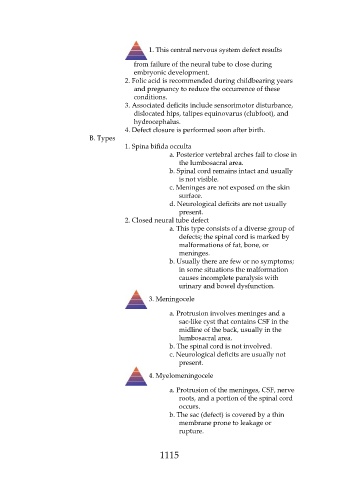Page 1115 - Saunders Comprehensive Review For NCLEX-RN
P. 1115
1. This central nervous system defect results
from failure of the neural tube to close during
embryonic development.
2. Folic acid is recommended during childbearing years
and pregnancy to reduce the occurrence of these
conditions.
3. Associated deficits include sensorimotor disturbance,
dislocated hips, talipes equinovarus (clubfoot), and
hydrocephalus.
4. Defect closure is performed soon after birth.
B. Types
1. Spina bifida occulta
a. Posterior vertebral arches fail to close in
the lumbosacral area.
b. Spinal cord remains intact and usually
is not visible.
c. Meninges are not exposed on the skin
surface.
d. Neurological deficits are not usually
present.
2. Closed neural tube defect
a. This type consists of a diverse group of
defects; the spinal cord is marked by
malformations of fat, bone, or
meninges.
b. Usually there are few or no symptoms;
in some situations the malformation
causes incomplete paralysis with
urinary and bowel dysfunction.
3. Meningocele
a. Protrusion involves meninges and a
sac-like cyst that contains CSF in the
midline of the back, usually in the
lumbosacral area.
b. The spinal cord is not involved.
c. Neurological deficits are usually not
present.
4. Myelomeningocele
a. Protrusion of the meninges, CSF, nerve
roots, and a portion of the spinal cord
occurs.
b. The sac (defect) is covered by a thin
membrane prone to leakage or
rupture.
1115

